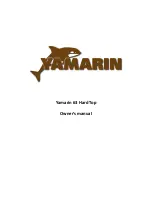
If you ground the boat on a sand bar, shut down the engine and seek help from
another boater or radio for help. See your dealer as soon as possible, as sand ingest-
ed in the engine cooling system can cause major engine damage. If you need to be
towed, we recommend using a commercial towing service.
Warning Markers
It is a good idea to find out about hazardous areas and how they are marked by ask-
ing local authorities.
•
Boaters must also recognize the flag designs which indicate that scuba divers
are present and keep well clear of the area.
•
Watch for swimmers. Swimming areas may not be marked, so always remain
alert.
•
Distress flags indicate a fellow boater is in need of assistance.
•
navigation markers serve as a means of identifying navigable routes and indi-
cate water hazards. Boaters should become familiar with navigation markers
and stay within marked boundaries and clear of hazards.
REACTING TO EMERGENCIES
Note
: In any emergency, the first thing all passengers must do is to put on their
PFDs.
Flooding
If the boat starts taking on water, start the bilge pump immediately. Open all compart-
ments and look for the cause of the flooding. Check all hoses and through hull fit-
tings. If flooding occurs as a result of collision or grounding damage, call for assis-
tance and head for shore if possible.
Capsizing
If the boat capsizes, and others were on board, find them and guide them to the
safety of the hull. even if the boat is floating upside-down, stay with it. rescuers
can spot a boat hull much easier than a human head sticking out of the water.
Do
not try to swim ashore; it may be further than it looks.
8.18
Deck cleats may pull free from deck. towline broken under tension may whip
about. to prevent injury, attach towline only to transom or bow towing eye. Stay
clear of towline attachment points on towed and towing boats.
G
E
T
T
IN
G
U
N
D
E
R
W
A
Y
Lund-08.indd 18
7/9/10 1:53 PM
https://www.boat-manuals.com/
















































